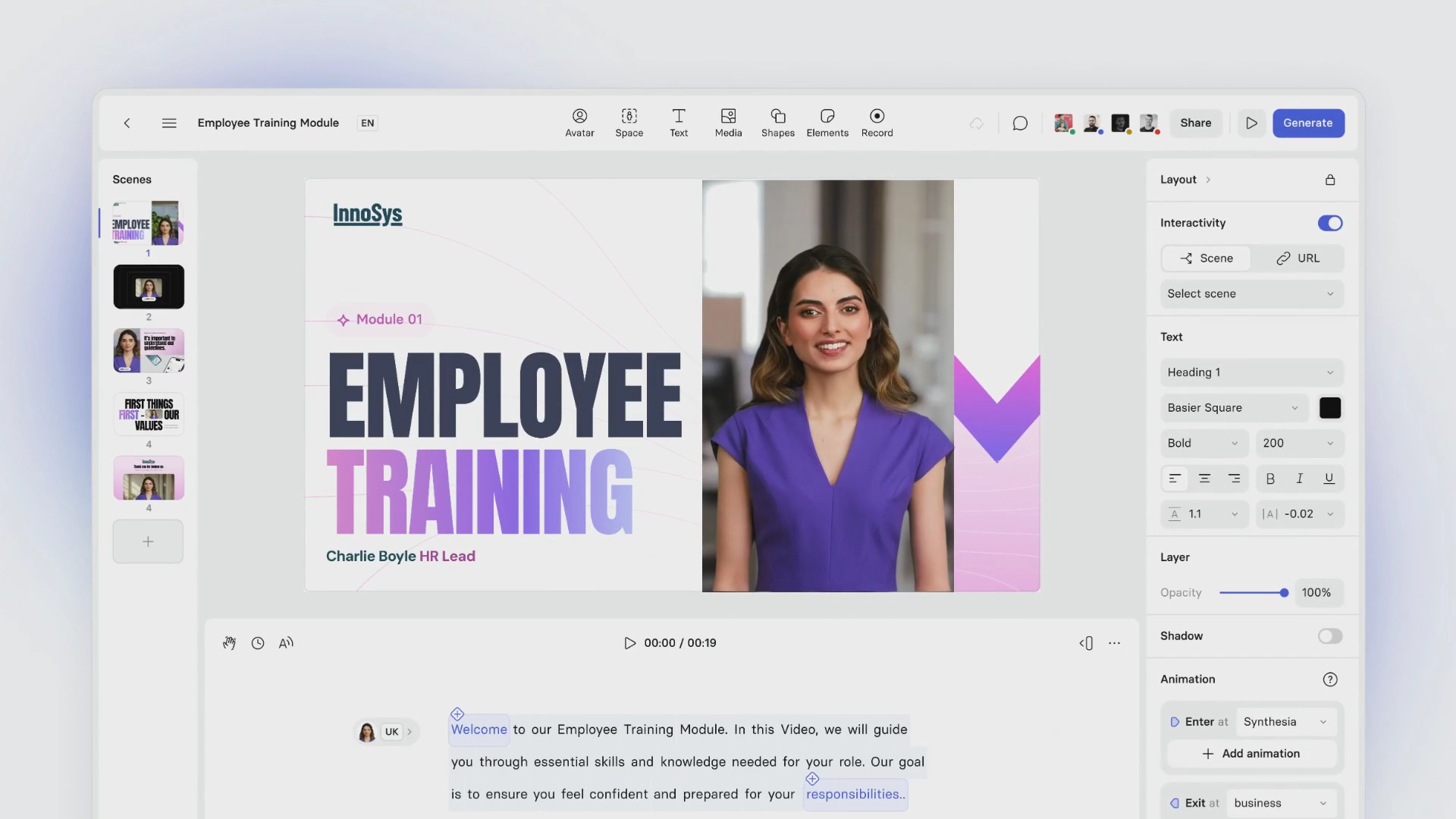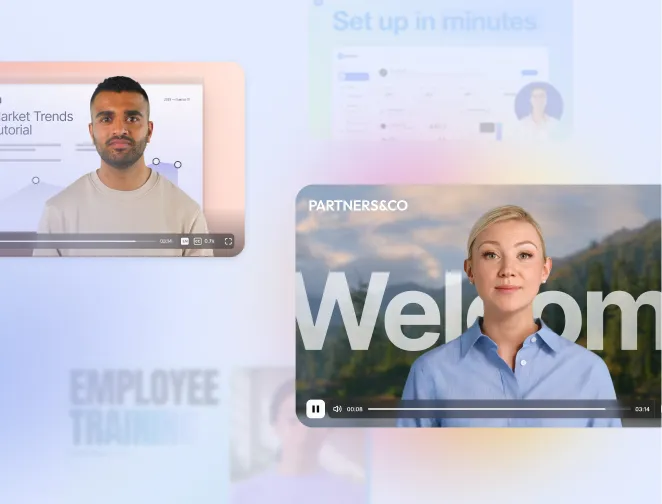
Create AI videos with 230+ avatars in 140+ languages.
Create engaging training videos in 140+ languages with Synthesia.
Even if your L&D budget is shrinking, the expectations are always rising.
Training Magazine’s 2024 Training Industry Report shows U.S. companies spent $774 per learner in 2024, down from $954 in 2023.
That cut hurts more than it looks. Translation can cost thousands per language, and underused seat-based licenses quietly drain spend.
But there's good news! You can reduce costs without lowering quality.
I’ll walk you through seven proven moves to refocus effort, optimize delivery, and use AI video to build engaging training in minutes.
Understanding your true training costs
Before you can effectively reduce training costs, you need to understand what you're actually spending. Most organizations focus on the obvious line items, but the full picture is often much more expensive than it appears.
Direct costs are just the beginning. You're paying for content creation and maintenance, instructor fees, platform licenses, and localization.
But then there are the hidden costs that rarely show up in budget reports: lost productivity when employees spend hours in training sessions, increased support tickets from poorly trained staff, and the massive expense of turnover when inadequate development drives people away.
I've worked with organizations that discovered they were spending thousands on vendor updates just to change a few sentences in their training materials.
Why reducing training costs shouldn't mean sacrificing quality
So, lowering expenses doesn't have to mean lowering standards—that sounds reasonable.
But while appealing in theory, it requires rethinking your entire approach to employee development.
Instead of reducing quality, the key is to define what "quality" really means for your team and how you'll know if you're providing it (or not).
That's why I would start by asking myself these two questions:
What defines high-quality employee training?
In my view, effective training always starts with relevance.
When learning is clearly tied to business goals and job roles, it's far more likely to stick and to drive performance. I've worked with teams that skipped this step and ended up with polished content that made no real impact.
Employee engagement matters just as much. Participation-based formats—like interactive video or hands-on scenarios—encourage active learning. People retain what they apply, not just what they read or hear.
And finally, great training programs are never static. They're shaped by feedback, adjusted over time, and refined based on what's working and what's not.
What happens when you compromise on quality?
Here's what happens: When training quality drops, confusion and rework creep in fast. Without proper training, teams spend time correcting avoidable mistakes instead of doing meaningful work.
You'll also feel it in retention. Employees who feel unsupported are more likely to leave, and replacing just one team member can cost between one-half to two times their annual salary, depending on the role and industry.
In many cases, poorly trained teams also report lower engagement and morale. That's because motivation plummets when growth opportunities disappear from the workplace.
Though slashing training budgets might temporarily balance the books, this approach ultimately costs far more than it saves.
But what alternatives exist for cost-conscious L&D teams looking to maintain quality? Let's have a look.
7 Cost-effective ways to reduce training costs (without cutting corners)
There's no shortage of ways to cut training costs, but not all of them are worth it.
The following cost reduction strategies focus on what actually works: reducing wasted time, effort, and budget on low-impact content, sharpening focus, and using the right digital tools to deliver training that's efficient, scalable, and effective.
1. Identify actual skill gaps—then target them
Wasteful practices of universal training regardless of need are thankfully disappearing from modern L&D. Thorough needs assessments allow L&D teams to focus training where it actually matters.
By analyzing performance data, conducting targeted surveys, and reviewing LMS analytics, you can pinpoint exactly where knowledge gaps exist.
In my experience working with L&D teams, this precision approach consistently delivers superior results while cutting unnecessary spending.
Organizations often discover that only specific segments of their workforce need certain advanced training.
When you target only those employees who truly need particular skills, you can significantly reduce costs while maintaining results.
To implement this strategy, I would recommend:
- Examining performance evaluations for recurring issues.
- Consulting managers about their teams' most pressing training needs.
- Analyzing customer feedback for patterns.
- Investigating support tickets for underlying knowledge deficiencies.
This targeted methodology creates learning experiences employees genuinely value while ensuring your training budget addresses business priorities that matter in the grand scheme of things.
I'll acknowledge that measuring training effectiveness remains challenging—it's something every L&D leader I've talked with struggles with.
But starting with clear performance metrics before training begins makes it easier to prove impact afterward. I've seen teams track metrics like time-to-competency reduction or support ticket volume drops as proxies when direct ROI is hard to measure.
2. Shift to online and asynchronous formats
Many organizations have already made the digital shift—80% of corporate training is now delivered online.
But here's the real opportunity: optimizing what you've built.
The challenge isn't just moving online; it's solving the specific problem that training takes people away from productive work.
In-person training racks up considerable expenses through travel, venues, catering, and instructor fees. These indirect costs regularly consume over half of traditional training budgets, creating a significant drain on resources.
Digital delivery eliminates these expenses while making content infinitely more scalable. Even better, asynchronous formats allow employees to access materials during natural workflow breaks, reducing productivity disruption.
I've watched organizations reduce onboarding time by over an hour per employee simply by letting people consume content during natural workflow breaks rather than scheduled sessions.
Learners gain the freedom to revisit key concepts anytime they need clarification, strengthening understanding at no extra expense.
Complex topics typically require multiple exposures before mastery occurs, so this flexibility becomes particularly valuable when teaching technical or detailed material.
Begin your transition by identifying which training materials and subjects naturally fit digital formats.
For instance, compliance requirements, product knowledge, and standardized procedures typically convert easily and deliver fast results.
Start with straightforward screencasts. Then track completion metrics and gather feedback to refine your approach before investing in more sophisticated solutions.
3. Use AI video creation to scale training quickly and affordably
Traditional video production demands substantial investment—often thousands per finished minute—plus weeks of production time.
In my experience working with L&D teams, the contrast with AI video generation is striking: what once took weeks and thousands of dollars now takes minutes at a fraction of the cost.
For budget-conscious L&D departments, this completely changes what's possible. AI-powered video creation for L&D purposes has completely transformed this equation.
Tools like Synthesia allow anyone to upload a script, select an AI avatar, and generate professional-quality training videos in minutes without cameras, studios, or editing expertise.
I've watched teams with no video production experience create engaging training content in a fraction of the time it would take using traditional methods.
Perhaps most impressive is the ability to localize content into over 140 languages. This capability makes multilingual training feasible for organizations that previously couldn't afford translation.
4. Embrace microlearning for faster, cheaper development
Too many organizations waste resources creating lengthy courses that learners never complete. Five-minute focused modules not only slash development time but actually improve learning outcomes through necessary content prioritization.
The compression process forces instructional designers to distinguish between "must-know" and "nice-to-know" information, resulting in concentrated learning experiences that deliver immediate value.
Modern employees appreciate this respect for their time constraints and limited attention spans. Research backs up this preference with concrete data: microlearning consistently generates higher engagement metrics, better knowledge retention, and more successful application of concepts in real-world situations.
To implement this approach effectively, break down complex subjects into single-objective components.
Use consistent visual formatting to support intuitive navigation, and design with mobile accessibility in mind to support learning on the go.
The payoff comes twofold: reduced development costs upfront and less time away from productive work during training—a compelling combination for any organization watching its bottom line.
5. Repurpose and reuse existing content
Untapped training resources already exist throughout your organization.
You'll find them in slide decks, SOPs, webinars, recorded meetings, and internal knowledge base articles. Much of this content was created for other purposes, but it often contains information employees need to know.
Converting these assets into short, focused video modules is one of the fastest ways to scale content without starting from scratch.
When I conduct content inventories with clients, they're often surprised by how much valuable training material already exists in different formats.
Course elements like visuals, recorded narrations, and digital presenters can serve multiple training needs while preserving brand identity.
Many companies adopting this modular content strategy have dramatically shortened development cycles while simultaneously improving information accessibility.
I recently worked with a team that converted their 40-slide onboarding deck into six 2-minute videos using existing visuals and script.
The content already existed—they just needed a faster way to make it consumable.
Many organizations are moving away from PowerPoint-based training because it's simply not engaging enough, and this repurposing approach gives that content new life.
It's a great way to stretch your training budget further while ensuring consistency across all training materials.
6. Standardize and automate onboarding
Most onboarding content remains consistent across all new hires despite being time-intensive to deliver.
Think about it—company policies, systems training, and process introductions stay virtually identical from one new employee to the next, yet organizations repeatedly invest significant resources presenting this same information.
Pre-built onboarding video modules that new employees can access immediately solve this redundancy problem.
Having implemented this approach with several clients, I've seen how it ensures every new hire receives the same high-quality introduction without requiring constant staff involvement.
From what I've observed, standardizing these common elements typically saves 1 hour or more per new hire in delivery time, plus eliminates the inconsistency that leads to follow-up questions.
When you're onboarding at scale, those hours add up fast—one client calculated they saved 50+ hours quarterly just by automating their compliance and systems training modules.
With these common elements automated, your team can focus resources on the personalized aspects of onboarding that truly require human interaction.
7. Track performance and cut what's not working
Analytics reveal surprising truths about which training content actually drives results.
Video engagement metrics, assessment scores, and completion patterns highlight both star performers and underachievers in your training library.
In addition, learner feedback provides crucial context beyond raw numbers, often revealing why certain content resonates while other materials fall flat.
This qualitative insight proves invaluable when refining your approach.
Organizations often discover that shorter, scenario-based modules followed by practice opportunities yield better results in less time than comprehensive employee training programs.
In other words, cutting underperforming content lets you concentrate resources where they'll make the biggest difference.
I recognize that proving training ROI remains one of L&D's toughest challenges—it came up in nearly every conversation I've had with training leaders.
While perfect attribution is rare, I've found that tracking leading indicators like completion rates, time-to-competency, support ticket volume, and manager feedback provides enough signal to identify what's working.
The key is setting these metrics before you build, not after.
When you take this data-driven approach, your budget naturally shifts toward what actually works—maximizing your return while eliminating wasted spending.
Final thoughts: Cut training costs, not quality
While shrinking budgets create real pressure, the most successful L&D teams view constraints as catalysts for innovation rather than barriers to quality. This means they rethink how training gets built, delivered, and scaled.
The L&D teams I most admire aren't just cutting costs—they're fundamentally rethinking what scalable, effective training looks like.
They're asking "How do we train 10x more people without 10x more budget?" rather than "Where do we trim 10%?" That mindset shift, combined with the right tools, is what separates teams that survive budget cuts from those that thrive despite them.
This shift opens the door to smarter training solutions. From AI-powered video creation to analytics-driven optimization, these approaches deliver better learning experiences that respect both budgets and learners' time.
About the author
Strategic Advisor
Kevin Alster
Kevin Alster heads up the learning team at Synthesia. He is focused on building Synthesia Academy and helping people figure out how to use generative AI videos in enterprise. His journey in the tech industry is driven by a decade-long experience in the education sector and various roles where he uses emerging technology to augment communication and creativity through video. He has been developing enterprise and branded learning solutions in organizations such as General Assembly, The School of The New York Times, and Sotheby's Institute of Art.

Frequently asked questions
What is the formula to calculate the true cost of employee training, including hidden costs?
The true cost of employee training equals your direct spending (licenses, content creation, instructor fees, localization) plus hidden costs that rarely appear in budget reports. To calculate this accurately, take your direct costs and add the hourly rate of every employee in training multiplied by their training hours, then factor in downstream expenses like support time spent answering questions from poorly trained staff, error correction costs, and employee turnover expenses when inadequate development drives people away.
Many organizations discover their actual training costs are double their initial calculations once they account for lost productivity, increased support tickets, and the massive expense of replacing employees who leave due to insufficient training. For example, replacing just one team member can cost between one-half to two times their annual salary, making talent retention through quality training a critical cost-saving strategy rather than an expense to minimize.
Can better training actually reduce overall business costs (turnover, errors, support tickets)?
Yes, investing in quality training creates a powerful ripple effect that reduces costs across your entire organization. Companies with comprehensive training programs report 24% higher profit margins and 30-50% increased retention rates, while organizations that provide proper training see 218% more profit per employee and 45% lower turnover rates.
The cost savings extend beyond retention into daily operations. Well-trained employees make fewer errors that require correction, generate fewer support tickets that drain IT resources, and work more efficiently without constant supervision. When you consider that 40% of employees leave within a year due to insufficient training and that U.S. businesses lose up to a trillion dollars yearly on voluntary turnover, the ROI of quality training becomes clear: every dollar spent on effective training saves multiple dollars in recruitment, onboarding, error correction, and lost productivity.
How does AI video creation with Synthesia lower training production and localization costs?
AI video creation transforms the economics of training content by eliminating traditional production expenses and making instant updates possible. Where traditional video production costs $1,000 to $8,000 per finished minute and requires weeks of production time with cameras, studios, and editing teams, AI-powered platforms like Synthesia allow anyone to create professional training videos in minutes by simply uploading a script and selecting an AI avatar.
The most dramatic savings come from localization, where AI fundamentally changes the cost equation. Traditional localization requires separate voice recording sessions, new presenter scheduling, and full re-edits for each language, often costing thousands per language. With AI video creation, you maintain one master script and generate versions in over 140 languages with a single click, cutting localization time by 80% or more and reducing per-language costs from thousands to near-zero. Companies report saving $5,000 to $15,000 per video compared to traditional production methods, while also gaining the ability to update content instantly when policies or processes change.
Which parts of our training program should move to online, asynchronous, or microlearning to save money?
Start by moving standardized, repeatable content that remains consistent across all learners to digital formats. Company policies, systems training, compliance requirements, product knowledge, and basic onboarding procedures naturally fit online delivery and can save significant resources when converted to asynchronous formats that employees access during natural workflow breaks rather than scheduled sessions.
Microlearning works particularly well for technical skills, software tutorials, and process updates where employees need quick, focused information they can immediately apply. By breaking complex topics into 1-3 minute modules, you reduce development time while improving retention and allowing employees to learn without extended time away from productive work. Reserve in-person training for high-stakes skills requiring practice and feedback, leadership development needing personal interaction, and team-building activities where human connection is the primary goal. This targeted approach typically saves organizations 1 hour or more per employee in delivery time while ensuring each training method matches its content's specific needs.
What metrics should we track to prove training ROI and decide where to reduce spend?
Track both leading indicators and business outcomes to build a complete picture of training effectiveness. Start with engagement metrics like completion rates, time-to-competency, and video view duration to identify which content resonates with learners, then connect these to business metrics such as support ticket volume, error rates, employee retention, and manager feedback scores to demonstrate real impact.
The key is setting these metrics before you build training, not after, and using them to guide resource allocation. For example, if data shows that shorter, scenario-based modules achieve 80% completion rates while lengthy presentations drop to 40%, you can confidently shift budget toward what works. Organizations that take this data-driven approach often discover surprising truths, like microlearning modules delivering better results in less time than comprehensive programs, allowing them to cut underperforming content and concentrate resources where they make the biggest difference in employee performance and business outcomes.










.png)



